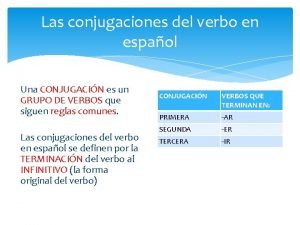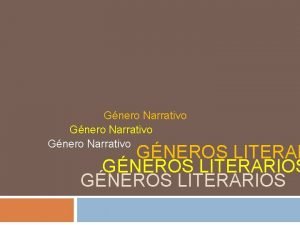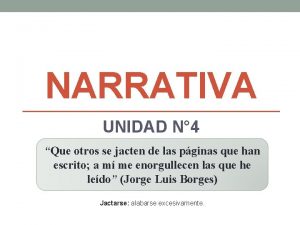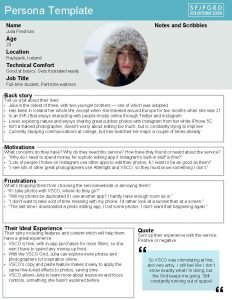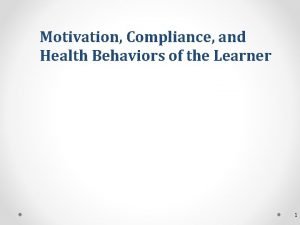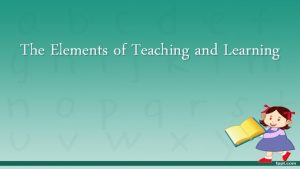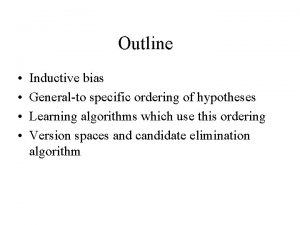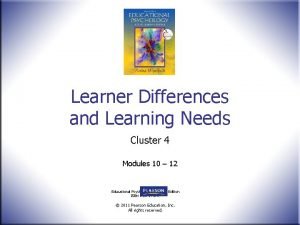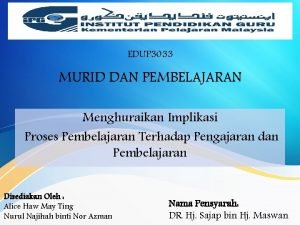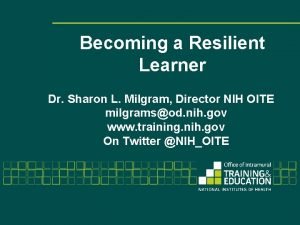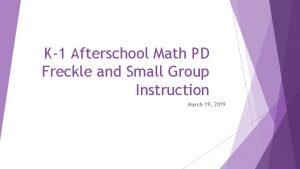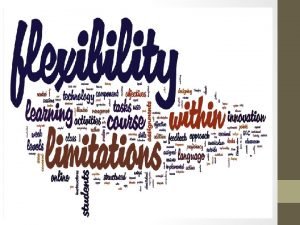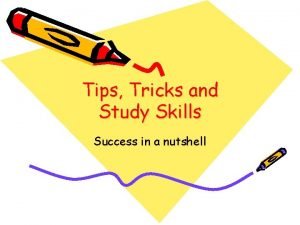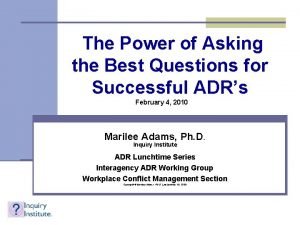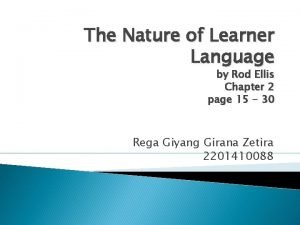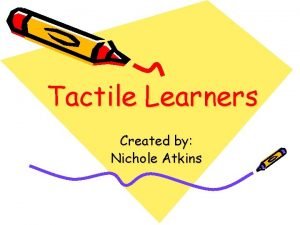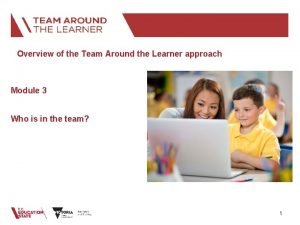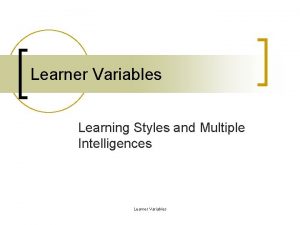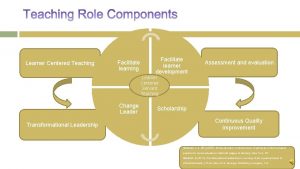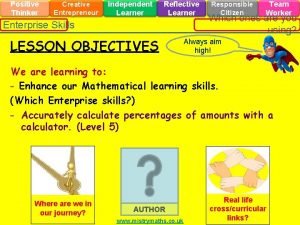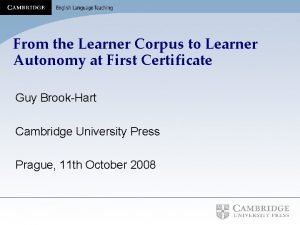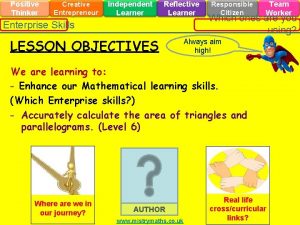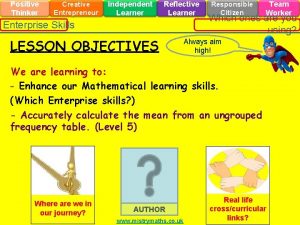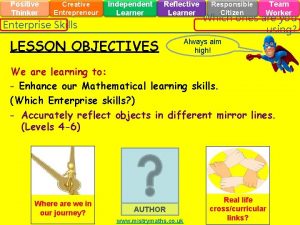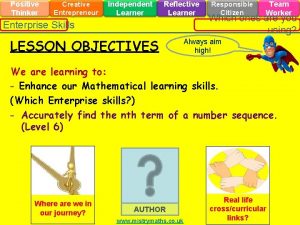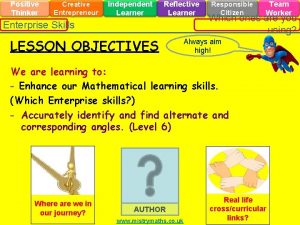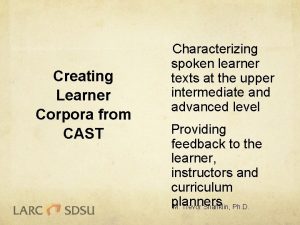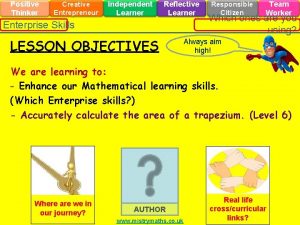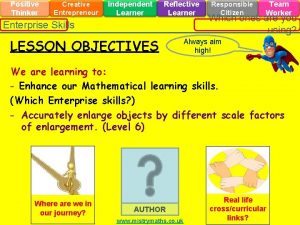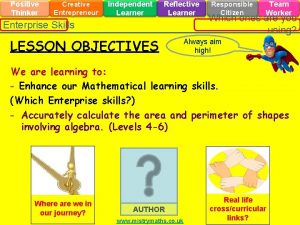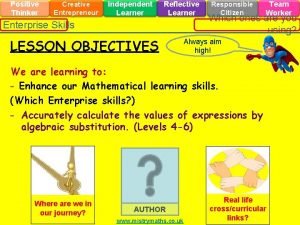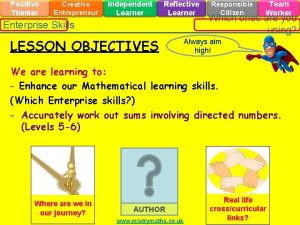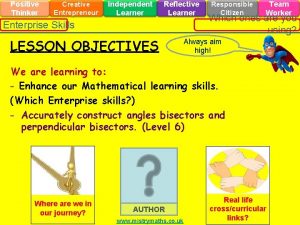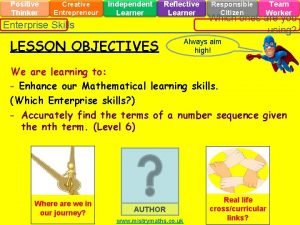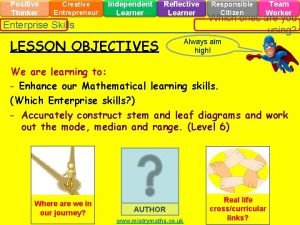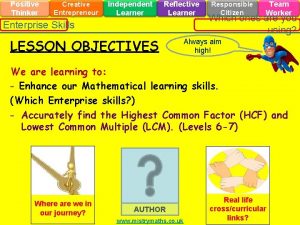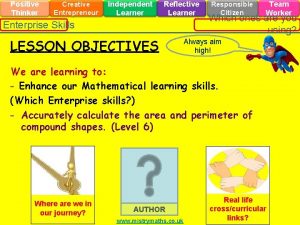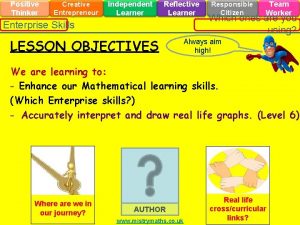A Student Geography Persona and A Learner Persona































- Slides: 31

A Student Geography Persona and A Learner Persona Walk Into a Bar… Now What? Researchers (in alphabetical order) • Chuck Dziuban, University of Central Florida, charles. dziuban@ucf. edu • Flora Mc. Martin, Broad-based Knowledge, flora. mcmartin@gmail. com • Glenda Morgan, University of Illinois Urbana, gmorgan@illinois. edu • Josh Morrill, Morrill Solutions Research, joshua@morrillsolutions. com • Patsy Moskal, University of Central Florida, patsy. moskal@ucf. edu • Alan Wolf, University of Wisconsin at Madison, alanwolf@wisc. edu

Background of the Study

Our survey – A brief history 3 useful groups to compare: N = 1, 749 $ Post. Faculty Study Marketing vendor for student sample 1) Current students Total Sample (full time part time, etc. ) 2) Past students / Alumni 3) Never students/ Never went to college.

Some Findings…

Student status (n = 1, 740) 60% 53% 50% 40% 31% 30% 20% 9% 10% 8% 0% Full-time student Part-time student Former student Never a student

Type of institution most recently attended (n = 1, 555) 4% 17% 16% 2 Yr Comm College 4 Yr School or Univ. 2% Trade/Tech School or Univ. Comp or Research Univ. 62% Other/Do Not know

The Personas

How were personas derived? Started with the questions on learning / studying preferences (same questions used for factor development) Conducted a Latent Class Analysis on these items Found different, internally consistent subgroups. Developed personas to help explain these subgroups.

Student personas Went from these… § I solve problems using a plan § I am systematic in my learning § I prefer to set my own learning goals § I enjoy studying § I have a need to learn § I set specific times for studying § I alter my practices when presented with new information § When presented with problems I cannot solve, I ask for assistance § I am confident in my ability to search for information …To these… Ambivalent Learners Adaptive Learners Free Form Learners Time Sensitive Learners

Student personas Important Considerations of These Personas - Limited to U. S. sample - We focused on current / active students (and limited age range for collection) - We are not yet sure about state vs. trait

Student persona 1: Ambivalent learners 48% of Sample Largest Segment § Do not feel strongly about learning § Confident in ability to find information § Do not enjoy studying § Do not have a need to learn

Student persona 2: Adaptive learners 26% of Sample § Solve problems with a plan § Set learning goals § Ask for help if they experience a problem § Enjoy studying § Do NOT set specific times to study

Student persona 3: Free form learners 13% of Sample § Least likely to set specific times to study § Do NOT solve problems with plans § DO have a need to learn § ARE willing to change what they do when presented with new information § NOT systematic in learning

Student persona 4: Time sensitive learners 11% of Sample § Similar to Adaptive (“Ideal”) Learners in many ways…just not as strong/extreme on the dimensions § MOST likely to set aside specific times to study § Do NOT solve problems with plans § LEAST likely to ask for assistance if they encounter a problem

Persona demographics

Personas and blended learning % desiring…All face-to-face, half-and-half, or all online courses

Ambivalence at Work Were you satisfied with your online course? Well. . .

Ambivalence “In retrospect, it seems rather simplistic to think of attitudes as always being unidimensional. After all, who hasn’t experienced ‘mixed feelings’ about people, places, and things. ” § Craig & Martinez (2005)

Three good books about ambivalence

Overall rating of the instructor 5 4 3 2 1 t t t n n n o o e le e l l N N a a a v v t e e i v i i t v n v b b i i b n e t t i al m m a ale m s A g A v o A e iv P bi e e v N v b i i m t t i m a s a a g o P Ne

Student satisfaction dimensions Positive Non. Ambivalent Positive Ambivalent Course Landscape Course Rhythm Course Landscape Instructor Engagement Expectation Rules Instructor Engagement Benchmark Progress Instructor Engagement Benchmark Progress r =. 61 Benchmark Progress r =. 58 r =. 41 Instructor Responsiveness r =. 43 r =. 38 Negative Ambivalent Negative Non. Ambivalent

Prototype 1 Course Rhythm Expectation Rules 5 4 3 2 1 Average Joe = 3 Benchmark Progress Instructor Engagement Responsiveness

Prototype 2 Course Rhythm Expectation Rules 5 4 3 2 1 Cold Fish = 3 Benchmark Progress Instructor Engagement Responsiveness

Prototype 3 Course Rhythm Expectation Rules Benchmark Progress 5 4 3 2 1 What do you want? = 3 Instructor Engagement Responsiveness

Prototype 4 Course Rhythm Expectation Rules 5 4 3 2 1 Where am I? = 3 Benchmark Progress Instructor Engagement Responsiveness

Now what?

Mass customization The students of today will be there parents of students tomorrow 0 3 0 2 P M I C I L I T A S N O

The learners of today – will be the parents of learners tomorrow The Personas? Great Depression Great Recession § Possibly more Time-Sensitive learners? § A new type / breed of ambivalent learners?

Mass customization! (Have it your way…) The Personas? § STUDENTS ARE NOT THE SAME § Time-sensitive and Free-form learners do not want the same thing which way?

What should we do NOW? • Deep dive into ambivalence? • Look at contexts / stability of personas? • Something else…. ? What would be MOST useful to see as the next step of this research?

Questions and comments Glenda Morgan glenda. morgan@gmail. com @morganmundum Or one of the other researchers on the project Chuck Dziuban, University of Central Florida, charles. dziuban@ucf. edu Flora Mc. Martin, Broad-based Knowledge, Flora. Mc. Martin@gmail. com Josh Morrill, Morrill Solutions Research, Joshua@morrillsolutions. com Patsy Moskal, University of Central Florida, patsy. moskal@ucf. edu Alan Wolf, University of Wisconsin at Madison, alanwolf@wisc. edu Support for this project was provided by the National Science Foundation DUE award no. 1049537 Any opinions, findings, and conclusions or recommendations expressed are those of the authors and do not necessarily reflect the views of the National Science Foundation
 Lazy learners vs eager learner
Lazy learners vs eager learner Objetivo de los pronombres personales
Objetivo de los pronombres personales Verbo en modo indicativo
Verbo en modo indicativo Genero literario ejemplos
Genero literario ejemplos Qué es en primera persona
Qué es en primera persona Learner persona template
Learner persona template How to write an frq for ap human geography
How to write an frq for ap human geography 5 themes of geography ap human geography
5 themes of geography ap human geography Ap human geography political geography test
Ap human geography political geography test Compliance motivation and health behaviors of the learner
Compliance motivation and health behaviors of the learner The arrangement of the elements of curriculum is known as
The arrangement of the elements of curriculum is known as Appetitive faculties
Appetitive faculties Inductive biased hypothesis space and unbiased learner
Inductive biased hypothesis space and unbiased learner Learner differences and learning needs
Learner differences and learning needs My score in the study habits questionnaire
My score in the study habits questionnaire Implikasi terhadap pengajaran dan pembelajaran
Implikasi terhadap pengajaran dan pembelajaran Sharon milgram
Sharon milgram How did you...your last weekend
How did you...your last weekend What did you do over the weekend
What did you do over the weekend Clearinghouse student tracker
Clearinghouse student tracker Class maths student student1 class student string name
Class maths student student1 class student string name National student clearinghouse student tracker
National student clearinghouse student tracker Https://student.freckle.com/#/
Https://student.freckle.com/#/ Good morning greetings for students
Good morning greetings for students Sls reset password
Sls reset password Limitations for students
Limitations for students Fyoutu
Fyoutu Ib learner portfolio
Ib learner portfolio Learner judger choice map
Learner judger choice map The nature of learner language
The nature of learner language Tactile learner definition
Tactile learner definition Team around the learner
Team around the learner


